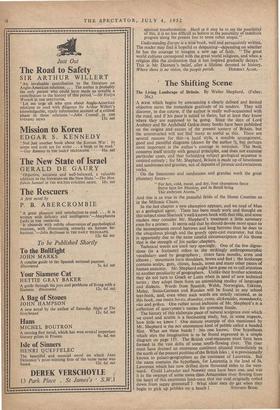' The Shifting Scene
The Living Landscape of Britain. By Walter Shepherd. (Faber. 36s.)
A BOOK which begins by announcing a clearly defined and limited objective earns the immediate gratitude of its readers. They will discover, in due course, if the author is really well-acquainted with the road, and if his pace, is suited to theirs, but at least they know where they are supposed to be going. Since the days of Lord Avebury and Sir Archibald Geikie many books have been published on the origins and causes of the present scenery of Britain, but the uninstructed will not find many as useful as this. There are several reasons for this—a lucid style, a sensible arrangement, good and plentiful diagrams (drawn by the author ?), but perhaps most important is the author's courage in omission. The book concerns itself strictly with general principles, and does not examine particular cases, and that forbidding subject geological sequence is omitted entirely ; for Mr. Shepherd, Britain is made up of limestones and sandstones and granites, not of deposits of jurassic and cretaceous rocks.
On the limestones and sandstones and granites work the great planetary forces-
" For hot, cold, moist, and dry, four champions fierce
Strive here for Maistrie, and to Batell bring Thir embryon Atoms."
And this is as true in the peaceful fields of the Home Counties as in the Miltonic Chaos.
In the last chapter a new champion appears, and we read of Man as a geological agent. There has been much work and thought on this subject since Sherlock's well-known book with that title, and some readers may consider Mr. Shepherd's treatment a little summary even for a primer. It seems odd that he should devote more space to the inconspicuous round barrows and long barrows than he does to the ubiquitous plough and the greedy open-cast excavator, but this is apparently due to the same careful circumscription of his theme that is the strength of this earlier chapters.
Technical words are used very sparingly. One of the few digres- sions (in a footnote) refers to the strikingly anthropomorphic vocabulary used by geographers ; rivers have mouths, arms and elbows ; mountains have shoulders, brows and feet ; the landscape contains scalps, guts, chines, heads, noses and many other pieces of human anatomy. Mr. Shepherd might have gone on to call attention to another peculiarity of geographers. Unlike their brother scientists they do not turn to Greek or Latin when in need of new technical terms ; they adopt them from an astonishing medley of languages and dialects. Words from Spanish, Welsh, Norwegian, Eskimo, Malay, Swiss-German and Russian will be found in any school text-book, and, even when such words are strictly rationed, as in this book, one meets horsts, drumlins, cwms, slickensides, monadnocks, rias and grikes. One rather novel inclusion of Mr. Shepherd's is a collection of quarrymen's names for common fossils.
The history of this elaborate piece of natural sculpture over which we crawl and scuttle is a fascinating study, but, in some respects, how little we know ! One minute example of this mentioned by Mr. Shepherd is the not uncommon kind of pebble called a banded flint. What are these bands ? No one knows. One hypothesis which stirs the imagination is to be found expressed in a simple diagram on page 155. The British coal-measures must have been formed in the vast delta of some south-flowing river. The river must have drained an enormous continent situated immediately to the north of the present position of the British Isles ; it is provisionally known to palaeo-geographers as the continent of Laurentia. But the name contains the hypothesis, for Laurentia is the land of St. Lawrence which has now drifted three thousand miles to the west- ward. Could Labrador and Norway once have been one, and was it in the swamps of some more than Amazonian river flowing from the heart of this enormous land-mass that our coal originally rotted down from sappy greenstuff ? What ideas men do get when they
begin to pick up pebbles on a beach 1 STEPHEN BONE.


























































 Previous page
Previous page